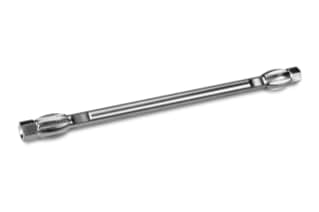
|
Chemistry |
C18 |
|
Separation Mode |
Reversed Phase |
|
Particle Substrate |
Hybrid |
|
pH Range Min |
1 pH |
|
pH Range Max |
12 pH |
|
Maximum Pressure |
6000 psi (415 Bar) |
|
Endcapped |
Yes |
|
Bonding Technology |
MS C18 |
|
Silanol Activity |
Low |
|
Particle Shape |
Spherical |
|
Particle Size |
3.5 µm |
|
Endfitting Type |
Waters |
|
Pore Size |
125 Å |
|
Format |
Column |
|
Surface Area |
175 |
|
System |
HPLC |
|
USP Classification |
L1 |
|
Inner Diameter |
4.6 mm |
|
Length |
150 mm |
|
Carbon Load |
16 % |
|
UNSPSC |
41115709 |
|
Brand |
XTerra |
|
Product Type |
Columns |
|
Units per Package |
1 pk |
XTerra MS C18 Column, 125Å, 3.5 µm, 4.6 mm X 150 mm, 1/pk
The XTerra MS C18 Column is designed for compatibility with Mass Spectrometry applications to provide sharp peaks, good sensitivity, and large peak capacities. These benefits are possible only with the embedded polar group technology available through the trifunctional bonding chemistries of XTerra MS columns. This technology also enables long lifetimes over a wide pH range while offering maximum throughout, excellent resolution, and ultra-low bleed. Waters recommends the use of an XTerra MS C18 VanGuard Cartridge, 125Å, 3.5 µm, 3.9 mm X 5 mm, 3/pk to extend lifetime even further.
The XTerra particle used in these columns contains both inorganic (silica) and organic (organosiloxane) components, offering the advantages of both materials in a single column. This Hybrid Particle Technology allows one out of every three silanols to be replaced with a methyl group during synthesis, distributing hydrophobicity throughout the entire structure of the particle backbone. This leads to a rugged hybrid particle that can be operated at high speeds, high temperatures, and high pH while still giving exceptionally sharp, high-efficiency peaks in basic compounds.
With universal acceptance from pharmaceutical scientists across drug discovery, method development, and isolation and purification, Waters’ XTerra columns are the fastest-selling and most successful column product in the world of chromatography lab equipment. This is due to the enabling science of Hybrid Particle Technology with something for all applications: drug discovery scientists benefit from the DMSO injection-resistance offered by the rugged XTerra particle, method development scientists are able to operate at any pH necessary for optimal selectivity, and isolation and purification scientists can load up to 60 times more material per injection thanks to the high mass loading capacity.
What Are The Advantages Of Organic And Inorganic Packings?
Inorganic (silica) packings are preferred for their mechanical strength, high efficiency, and predictable retention. However, they also have a limited pH range and can result in tailing peaks for bases. They are also more chemically unstable. Organic (polymer) packings can work with a wide pH range and have no ionic interactions. They also offer superior chemical stability. As opposed to inorganic packings, they are mechanically weaker and have lower efficiency and unpredictable retention. Hybrid Particle Technology offers the advantages of both packings while accommodating for the disadvantages of each.